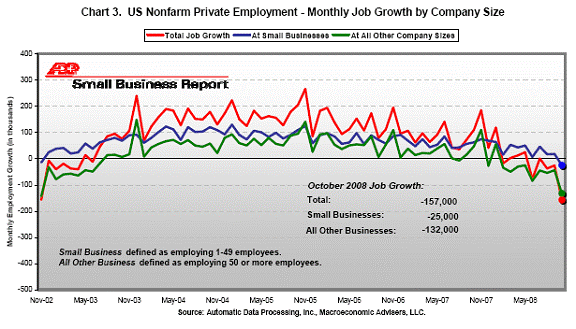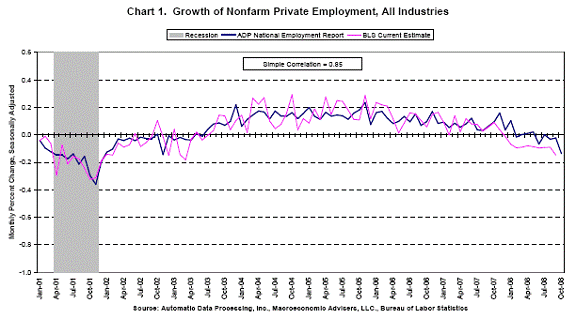Further evidence that the small business segment of the economy is undergoing stress. From the ADP National Employment Report:
[Joel] Prakken added, “This month’s employment loss was driven by the goods-producing
sector which declined 126,000 during October, its twenty-third consecutive monthly
decline. The manufacturing sector marked its twenty-sixth consecutive monthly decline,
losing 85,000 jobs. These losses were compounded by an employment decline in the
service-providing sector of the economy which fell by 31,000, the first loss in the serviceproviding
sector recorded by the ADP Report since November of 2002.”
“Large businesses, defined as those with 500 or more workers, saw employment decline
41,000, while medium-size companies with between 50 and 499 workers declined
91,000. Employment among small-size businesses, defined as those with fewer than 50 workers, declined 25,000. This is the first outright decline in small business employment reported by the ADP Report since November of 2002, and the largest percentage decline
since the economy was emerging from recession in early 2002,” said Prakken.
Here is a graph breaking down the employment declines.

And here is a figure depicting the implications for the nonfarm payroll employment figures, keeping in mind the loose correlation between the ADP numbers and NFP numbers.

I think Prakken’s last point regarding the downturn in small business employment is of substantial interest as policymakers consider options going forward — and not only because it puts to rest the dichotomy between Wall Street and Main Street. The appropriate policies depend, in part, upon the reasons for why employment is declining — credit crunch vs. recession. Obviously both are probably at work, but the proportions are of importance. To the extent the credit crunch is the main issue, the Fed and Treasury need to continue their effort to loosen up lending, and at the minimum reduce the likelihood of financial institution bankruptcies.
The last National Federation of Independent Business report did not indicate credit concerns were high; from the October report (pertaining to September):
Regular small business borrowers report that credit is increasingly more
difficult to obtain. This has risen to 11 percent in September (12 percent
said “harder”, 1 percent “easier”) as the creditworthiness of potential
borrowers does decline as the economy weakens and customers disappear.
Because a slowdown in the economy changes the credit worthiness of
potential borrowers as sales and profits decline, more “rejections” will
occur even with no change in credit standards by lenders. And, many credit
worthy borrowers don’t need credit in a period when business expansion
makes no sense and inventories are being reduced, not increased. Thus, the
aggregate amount of business loans will fall with no change in credit
standards. Regular borrowing activity was reported by 32 percent of the
owners (down 2 points), reflecting a reduced need for funds to support
inventory accumulation or discretionary capital spending. Both inventory
and capital investment plans have been declining as the economy has
weakened. So, credit demand is down and fewer loans are being made, but
not directly due to a lack of credit availability. Loan demand is lower for
many firms. Thirty-three (33) percent reported all their borrowing needs
met compared to 6 percent who reported problems obtaining desired
financing. The net percent responding favorable was 2 points lower than
August and 2 points better than July. Interestingly, 36 percent reported all
credit needs met in the tumultuous second half of September, compared to
31 percent in the first few weeks of the month.
Since some of the survey results pertain to the period before the financial crisis, beginning in mid-September, it’s of use to see assessments that are more recent. Here is one in contained in Congressional testimony from about a week ago; this statement is from the Chair of the Small Enterprise Committee of the Association of Equipment Manufacturers:
While Wall Street is on a financial roller coaster, I am here to tell you that many small businesses in America are in an economic freefall. AEM members, like the rest of the country, are experiencing challenges due to the credit and liquidity crisis.
….
I have heard from several colleagues on how they are experiencing problems with obtaining lines of credit. One of them, a small manufacturer in rural South Carolina, had an operating line of credit with Wachovia that was secured by a stock portfolio, but with the unraveling of the market their line was frozen. Attempts to restructure their line with Wachovia stopped before they started and inquiries into other banks were met with a “we are only engaging in lending with existing bank customers” type responses. Now my colleague is spending most of his time trying to resolve the issue when he should be working to secure orders in this down market. Still other colleagues of mine have capital to operate but find their orders disappearing, in part because their consumers cannot get credit to make the purchase.
I found this testimony of interest, even taking into account the fact that the representative has an interest in conveying the situation in the starkest terms, because it lays out the web of interconnections to areas which I would not have expected an impact. The testimony continues:
We are now seeing farmers delay the purchase of these inputs [fertilizer, seed, chemicals and fuel] from their “normal” pre-season purchasing patterns as they are having trouble accessing credit and are hesitant to pay such steep prices…
What the foregoing highlights is that for sure credit concerns are important, although the relative importance of decreasing demand is probably rising over time. So, the predictions I made in a post a month and half ago — about how small businesses will likely be very impacted by this financial crisis — have to some extent come to pass.
By the way, for those who doubted the reality of the financial crisis, see the Boston Fed’s rejoinder (coauthored by Wisconsin PhD Ethan Cohen-Cole) to that Minneapolis Fed “myths” paper (h/t Mark Thoma).
Technorati Tags: small business, credit crunch,
employment, Wall Street,
and Main Street.
The weakness of the Boston Fed’s rejoinder leads me to question more seriously the claim that there was a ‘credit crisis.’ In particular, it makes me question more seriously whether Paulson’s solution was a good idea.
don – The Boston FED’s rejoinder indicated in figure 1A, that about $1 Trillion per year in asset backed securities have disappeared from the market…. Large Commercial banks have about DOUBLED their cash assets (probably from FED infusions, hedge fund loan calls, and investment flight to cash)… Commercial Paper spreads for Asset-Backed, Financial, and A2/P2 have spiked to very high levels.
Its clear to me (in figure 2) that Large Commercial Banks are hoarding cash . I would guess they are doing so in order to get their reserve levels in compliance, and for provisioning likely defaults on commercial bank loans and asset backed paper during the ensuing recession. Credit is draining out of the banking system… it has to when domestically, over $5 Trillion in real estate, and $8 Trillion in equity assets are vaporized!!! … Hold on to your hat – more losses are coming when Alt-A and Adjustable Rate mortgage payments are reset during the next three years, and LBO and private equity loans fail due to contracting cash flow.
“domestically, over $5 Trillion in real estate, and $8 Trillion in equity assets are vaporized!!! …”
No, they haven’t. People foolishly thought they were richer than they were. Now they know better. They were over-borrowing and now they aren’t. To me, ‘credit crisis’ means new lending that should get done won’t. It’s not clear that is the case, and there is nothing in the Boston Fed’s account to convince me otherwise.
The argument now is, we need to keep up unsustainable borrowing to prevent recession and the savings paradox (trying to save more leads to less saving). There is certainly some truth to the argument. But I’m not convinced that Paulson’s bailouts were the best course of action.
MarkS
You are certainly right about more losses coming. And existing losses have not been properly recognized, either. But the question is whether the right answer is to extend borrowing, and by how much. It is true that banks acting individually to cut back on loans in expectations of a declining economy and defaults might bring self-fulfilling adverse macroeconomic economic consequences, just as their over-lending did. But policies to keep up the lending may just end up postponing the problem until it is truly insoluble. I fear that in the end it will be proven that Japan’s policies were wiser than ours. IMO the choice is between a moderately hard downturn now, and the possibility of a truly disastrous downturn later. I opt for the former.
Don, an economist would always ask, “How much later?” before making the choice.
The historical record is that under the regime of letting things run their course, there were much more severe financial crises than there have been post-Keynes. And it makes sense. To take an analogy from medicine, we don’t let things take their course in disease because there is collateral damage. Letting a child’s strep throat run its course risks damage to the heart.
If we could confine the consequences to the institutions that caused the problems, maybe it would make sense to let things run their course. But there’s a lot of collateral damage. Businesses that had nothing to do with the mortgage crisis are unable to get loans normal to doing business. Homeowners who were very conscientious with their mortgages are finding their property values are falling because of foreclosed properties next to them. To allow the destruction of value in such cases is wanton and wasteful.
The American system once could afford to be wasteful. The nation has been getting relatively poorer and poorer as a consequence. Once we had vast reserves of minerals, timber, and other natural resources we could sell off to pay our way out of the jams we got ourselves in. Not any more. Laissez faire is dead.